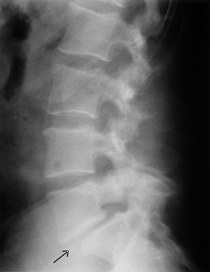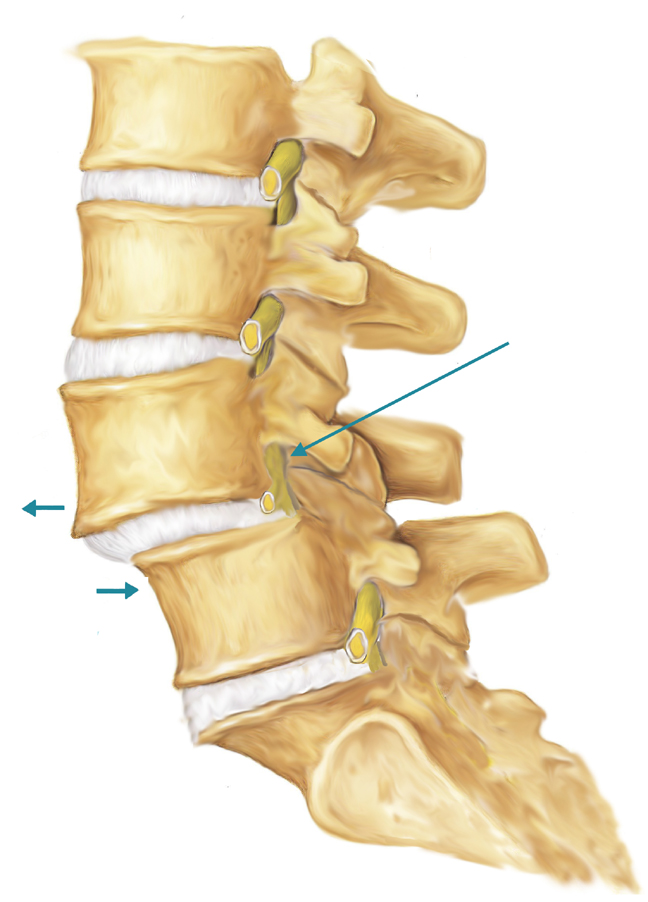Some people are symptom free and find the disorder exists when revealed on an X-ray. In advanced cases, the patient may appear swayback with a protruding abdomen, exhibit a shortened torso, and present with a waddling gait.
Spondylolisthesis can be congenital (present at birth) or develop during childhood or later in life. The disorder may result from the physical stresses to the spine from carrying heavy things, weightlifting, football, gymnastics, trauma, and general wear and tear. As the vertebral components degenerate the spine’s integrity is compromised.

Another type of spondylolisthesis is degenerative spondylolisthesis, occurring usually after age 50. This may create a narrowing of the spinal canal (spinal stenosis). This condition is frequently treated by surgery.
Symptoms and Non-Operative Treatment
Typical symptoms include low back pain, muscle spasms, thigh or leg pain, and weakness. Interestingly, some patients are asymptomatic and learn of the disorder following spinal radiographs.
Low back pain associated with DS is treated non-operatively. During the acute pain phase, bedrest may be recommended for a few days. Activities involving heavy lifting and stooping are prohibited to prevent stress to the lumbar spine.
Drug Therapy
During the acute phase of low back pain, drugs may be prescribed. Some of these may include narcotics, acetaminophen, anti-inflammatory agents, muscle relaxants, and anti-depressants.
Narcotics are used on a short-term basis partially due to their addiction potential. When low back pain is caused by muscle spasm, a muscle relaxant may be prescribed. Muscles relaxants are usually used no longer than one week and have sedative effects. Depression can be a factor in chronic low back pain. Anti-depressant drugs have analgesic properties and may improve sleep.
Bracing and Physical Therapy
Other conservative non-operative treatment may include a custom-made brace. A brace is designed to reduce the loads (weight) to the lumbar spine. Physical therapy may be added to the treatment plan. Forms of therapeutic exercise including stretching may improve the flexibility of the trunk muscles. Other non-aerobic exercises may help to improve muscular endurance, coordination, strength, and facilitate weight loss. Exercise also helps to combat anxiety and depression.

Disease Progression and Neurologic Deficit
Although degenerative spondylolisthesis may cause a vertebra to slip forward, that does not always mean the disorder is progressive. The vertebral segment may be stable without any neurologic compromise. Surgery becomes a consideration when the disorder causes neurologic deficit, such as incontinence or the slip progresses. Spinal fusion and instrumentation may become a consideration if slippage exceeds three millimeters. These surgical procedures stabilize the spinal column.
The surgeon bases his/her decisions on the patient’s medical history, symptoms, radiographic findings, as well as the degree and angle of the vertebral slip. Patients who use tobacco or are obese are known to have lower rates of success with fusion. Nicotine hampers the fusion process and obesity places excessive weight on the lumbar spine.
Symptoms and Non-Operative Treatment
Typical symptoms include low back pain, muscle spasms, thigh or leg pain, and weakness. Interestingly, some patients are asymptomatic and learn of the disorder following spinal radiographs.
Low back pain associated with DS is treated non-operatively. During the acute pain phase, bedrest may be recommended for a few days. Activities involving heavy lifting and stooping are prohibited to prevent stress to the lumbar spine.
Drug Therapy
During the acute phase of low back pain, drugs may be prescribed. Some of these may include narcotics, acetaminophen, anti-inflammatory agents, muscle relaxants, and anti-depressants.
Narcotics are used on a short-term basis partially due to their addiction potential. When low back pain is caused by muscle spasm, a muscle relaxant may be prescribed. Muscles relaxants are usually used no longer than one week and have sedative effects. Depression can be a factor in chronic low back pain. Anti-depressant drugs have analgesic properties and may improve sleep.
Bracing and Physical Therapy
Other conservative non-operative treatment may include a custom-made brace. A brace is designed to reduce the loads (weight) to the lumbar spine. Physical therapy may be added to the treatment plan. Forms of therapeutic exercise including stretching may improve the flexibility of the trunk muscles. Other non-aerobic exercises may help to improve muscular endurance, coordination, strength, and facilitate weight loss. Exercise also helps to combat anxiety and depression.
Disease Progression and Neurologic Deficit
Although degenerative spondylolisthesis may cause a vertebra to slip forward, that does not always mean the disorder is progressive. The vertebral segment may be stable without any neurologic compromise. Surgery becomes a consideration when the disorder causes neurologic deficit, such as incontinence or the slip progresses. Spinal fusion and instrumentation may become a consideration if slippage exceeds three millimeters. These surgical procedures stabilize the spinal column.
The surgeon bases his/her decisions on the patient’s medical history, symptoms, radiographic findings, as well as the degree and angle of the vertebral slip. Patients who use tobacco or are obese are known to have lower rates of success with fusion. Nicotine hampers the fusion process and obesity places excessive weight on the lumbar spine.
Minimally-invasive treatments for spinal spondylolisthesis
Treatment options in our clinic include micro-endoscopic treatments utilizing tubular retractor system and interspinous devices. With this treatments we enable patients to continue with a normal life, while preserving normal spine movements and avoid aggressive fusion surgery.
Spinal Fusion and Instrumentation
Spinal fusion and instrumentation are combined. Spinal fusion uses the patient’s (preferred) own bone harvested from the iliac crest (pelvis). Donor bone is an option. Spinal instrumentation uses medically designed implants such as screws and cages. The implant(s) holds the vertebral segment secure facilitating fusion. Instrumentation provides more rapid pain relief, recovery, and may eliminate the need for bracing following surgery. Two surgical procedures that utilize spinal fusion and instrumentation are termed Anterior Lumbar Interbody Fusion (ALIF) and Posterior Lumbar Interbody Fusion (PLIF). The difference between the two procedures is the surgical approach to treat the disorder (front or rear).
Conclusion
Although aging adults can expect some degenerative processes to occur in their spines, this certainly does not point to a future facing disability. In general, spondylolisthesis only affects a small percentage of the population. Overall, most degenerative disorders of the spinal can be treated non-surgically with good outcomes.
Spinal fusion and instrumentation are combined. Spinal fusion uses the patient’s (preferred) own bone harvested from the iliac crest (pelvis). Donor bone is an option. Spinal instrumentation uses medically designed implants such as screws and cages. The implant(s) holds the vertebral segment secure facilitating fusion. Instrumentation provides more rapid pain relief, recovery, and may eliminate the need for bracing following surgery. Two surgical procedures that utilize spinal fusion and instrumentation are termed Anterior Lumbar Interbody Fusion (ALIF) and Posterior Lumbar Interbody Fusion (PLIF). The difference between the two procedures is the surgical approach to treat the disorder (front or rear).